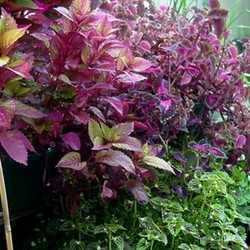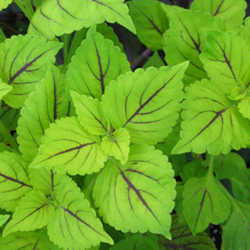Solenostemon scutellarioides is the long Latin name for the species we know as Coleus. Coleus was reclassified to Solenostemon in 2006 [1] and is still the common name used today in marketing and advertising the plants. Someday, a shortened version, like "soleno" might become a consumer-friendly marketing name for these beauties. Soleno is also a 6-letter word that is more-or-less an anagram (rearrangement) of the word coleus, using four of the same letters.
Whatever you call it, Solenostemon's attractive colors and textures make it an ideal plant for sun or shade gardens,  window boxes and containers. There are edible Coleus species too, one of which was reclassified as Solenostemon rotundifolius, an edible root vegetable that is prepared and eaten as "potatoes" in other countries; the other is Coleus forskohlii, an Ayurvedic herb with medicinal health benefits.
window boxes and containers. There are edible Coleus species too, one of which was reclassified as Solenostemon rotundifolius, an edible root vegetable that is prepared and eaten as "potatoes" in other countries; the other is Coleus forskohlii, an Ayurvedic herb with medicinal health benefits.
My quest for more information about these edible varieties led me to contact Ray Rogers, coleus expert and author of the book 'Coleus, Rainbow Foliage for Containers and Gardens'. Being curious and newly interested about Solenostemons, I was delighted for the interview opportunity.
1) What is your favorite Coleus and why?
Rogers said he didn't really have one favorite coleus, but if he had to choose one he said, "I would pick 'Alabama Sunset', because it changes."
'Alabama Sunset' bursts with changing odd color blends of pink, green and burgundy tones. And it is one of the ten most-photographed coleus here on Dave's Garden.
2) What type of garden do you have?
My home garden is formal and small. I grow most of my coleus at Atlock Farm nursery in Somerset, NJ.
3) For coleus newcomers, would you briefly define 'sport'?
"A Coleus 'sport' is when a change or mutation happens to the cells and results in a new color pattern. 'Freckles' is an old heirloom, It sported a famous Coleus called 'Sedona', which is very popular."
Sedona is part of the ColorBlazeTM series and was hybridized by Smith/Heulitt/Metzger and Avery in 2003. "Sedona was named after the Sedona mountains," and is a gorgeous rusty orange cultivar, informs DG member 'Joan' of Belfield, ND in a PlantFiles gardeners note.
4) Can Coleus be over-wintered indoors?
"It is tricky for a homeowner to over-winter coleus." According to Rogers, three things are of utmost importance in over-wintering coleus: 1) Warmth 2) Sun, and 3) Water (not too much). He says, "Plants overwintered need to be in a warm, sunny spot with careful watering." A greenhouse is ideal.
Coleus are annuals or tender perennials; they are not cold-tolerant and die in the winter. They can be grown inside as a houseplant, then will die and go to seed after blooming. If you do not want the plant to go to seed, cut off any flower spikes as they appear. Personally, I love the tiny light blue blooms and usually let ours bloom, and then just repurchase our favorites the following year. However, the larger your collection becomes, repurchasing your favorites every year could become expensive. Another option would be to propagate your existing plant(s) by root cuttings.
5) Do you have any information about the edible Coleus species, Coleus forskohlii or Solenostemon rotundifolius?
"Not really... I don't grow them...," Rogers replied.
I knew at that moment that I had embarked on yet another nutrition challenge! Below are my findings.
 Our interview ended leaving me looking forward to attending his 2009 group coleus garden visit to Atlock farms sometime during the summer. For more information, visit Ray Roger's website: http://coleussociety.org Our interview ended leaving me looking forward to attending his 2009 group coleus garden visit to Atlock farms sometime during the summer. For more information, visit Ray Roger's website: http://coleussociety.org |
Edible Coleus
Solenostemon is a fairly large genus in the mint family (Lamiaceae) and has long been cultivated in many countries including Africa, Indonesia and India. Several species of coleus are cultivated for their subterranean tubers and as an herb using the plants edible young stems and leaves.
Solenostemon rotundifolius
S. rotundifolius is known abroad by several common names: Hausa potato, Madagascar potato, Koorka, Ratala, Patata de los Hausas, Sudan potato or Coleus potato. Synonyms for this plant include Coleus rotundifolius and Plectranthus rotundifolius.
 Coleus potato has a prostrate or ascending habit and produces somewhat small but prolific, round tuber "potatoes", that are said to be slightly spicy and rather pleasant in flavor, with a moist and grainy texture.[2] The small, dark brown tubers are farmed as an annual and form in clusters around the base of the stem 150-200 days from planting.[3] Its foliage appears in classic Coleus style, with hand painted bright colors of pink inner veining, surrounded by deeper burgundy within a scalloped chartreuse edge.
Coleus potato has a prostrate or ascending habit and produces somewhat small but prolific, round tuber "potatoes", that are said to be slightly spicy and rather pleasant in flavor, with a moist and grainy texture.[2] The small, dark brown tubers are farmed as an annual and form in clusters around the base of the stem 150-200 days from planting.[3] Its foliage appears in classic Coleus style, with hand painted bright colors of pink inner veining, surrounded by deeper burgundy within a scalloped chartreuse edge.
Coleus forskholii
C. forskholii was named after the man who discovered it, Swedish Naturalist, Peter Forsskal. This sought-after root is used as food, but is also widely used in dietary supplements and pharmaceutical products.
Gaia Herbs, a company located in Brevard, NC. markets C. forskohlii products to health-food stores and businesses throughout the U.S. They grow many of their own herbs, but some, including C. forskohlii are imported. Product information spokesperson, Mandy Smith, RN says that Gaia purchases their C. forskohlii roots from India. "Currently we do not standardize this herb. We have not done any further analysis on this herb in our lab, apart from routine testing for heavy metals, pesticides and microbial counts." She also pointed out that their product is made from the whole plant and not just the roots, an implication of even greater possible benefits beyond just the benefits of forskolin, the major chemical compound found only in this Coleus species.
An Ayurvedic Herb
Coleus root has been used traditionally for over 3,000 years in Ayurvedic medicine. In ancient Sanskrit texts the herb is known as Makandi. It grows as a wild perennial and thrives in warm subtropical areas, like that found in India and similar regions. According to 'The Hindu', an Indian publication, Coleus forskholii is still a hardy crop and is grown in India by local and contract farmers, especially in Gujarat, Karnataka and Tamil Nadu, with approximately 2,500 tonnes cultivated annually. Farmers grow this drought tolerant species with little care and investment. [4]
[4]
C. forskohlii roots are used in medicines and eaten as pickles. Roots exported in bulk to manufacturers in the U.S. find their destiny to be ground into Coleus powder, extracts (forskolin) and then processed into capsule and extract blends marketed by herbal supplement companies like Gaia and others.
Coleus Herb Claims*
C. forskohlii is claimed to support healthy heart, lung, gastrointestinal and immune function, as well as help hypertension (high blood pressure), asthma, eczema, glaucoma, irritable bowl syndrome, and menstrual cramps. It stimulates cyclic adenosine monophosphate (cAMP) and may be beneficial for weight loss.
In the U.S., without significant research and scientific evidence, many claims are unsubstantiated and use has been limited. The active ingredient (forskolin) has been used in thousands of studies as an adenylyl cyclase activator and cAMP stimulator. Stimulating cAMP results in complex interactions within body cells that are beyond the scope of this article. Many internal cellular functions in our bodies are activated with the cAMP mechanism. The ability for forskolin to stimulate this has promising applications for medical professionals and those in pharmacology. Continued and new research for applications with forskolin and isolated compounds from this Ayurvedic Indian herb is developing.
Coleus Herb Nutrition
The main nutrient from roots and tubers is energizing carbohydrates. Plants are an important part of a healthy diet, contributing nutrients along with soluble and insoluble fiber; S. rotundifolius and C. forskohlii would be no exception and would provide a dietary source of fiber.
In a recent study by Rasineni, Siddavattam and Reddy[5], it was shown that extracts have high amounts of polyphenols, flavones, flavonols and antioxidant action. The researchers found free radical activity and polyphenols in three species of coleus that included C. forskholii. Further Coleus analysis and nutrition information for vitamin and mineral content is currently unavailable by the USDA.
As a gardener, I'm sure I'm not the only one who would like to try growing an edible Coleus species, but these plants or tubers are difficult to find.
* This article is not intended to be used in diagnosis or treatment in any disease. C. forskohlii should be taken with caution, especially by those on blood pressure medications or taking prescribed medications. The New York Langone Medical Center's web site notes that since forskolin (the active chemical in C. forskohlii) has such wide ranging properties, it is best to consult with your health care practitioner before taking it.
Photo Credits: Thumbnail chemical compound: forskolin, public domain symbol, background photo and Soleno Fishnet Stockings ©Wind. All photos used with permission: Solenostemon scutellarioides 'Sedona' ©2009 by DG member 'Slyperso1'. All other photos ©2009 by DG member 'DaleTheGardener'. All rights reserved.
Footnotes:
[1] Rogers R, Coleus Rainbow Foliage for Containers and Gardens, Timber Press, 2008; p 17.
[2] Food Resource, College of Health and Human Sciences, Oregon State University; COLEUS Excerpts from Hawkes, Alex D. 1968. A World of Vegetable Cookery. Simon and Schuster, New York. Accessed Dec. 2008.
[3] FAO- Food and Agriculture Organization of the UN, Ecocrop data sheet: Solenostemon rotundifolius. Accessed Dec. 2008
[4] Prabu MJ, The Hindu, India's National Newspaper, Farmer's Notebook Contract farming of Coleus forskholii gaining popularity. Accessed Dec.11, 2008.
[5] Rasineni GK, Siddavattam D, Reddy AR, Free radical quenching activity and polyphenols in three species of Coleus, Journal of Medicinal Plants Research, Vol 2(10), pp285-291, Oct. 2008.
Related Links: Coleus, Clemson Extension Home and Garden Information
Scheduled events and more about Ray Rogers from Timber Press
Visit the Dave's Garden Coleus forum
Further Reading: Is This Plant the New Hosta? By Larry Rettig

















